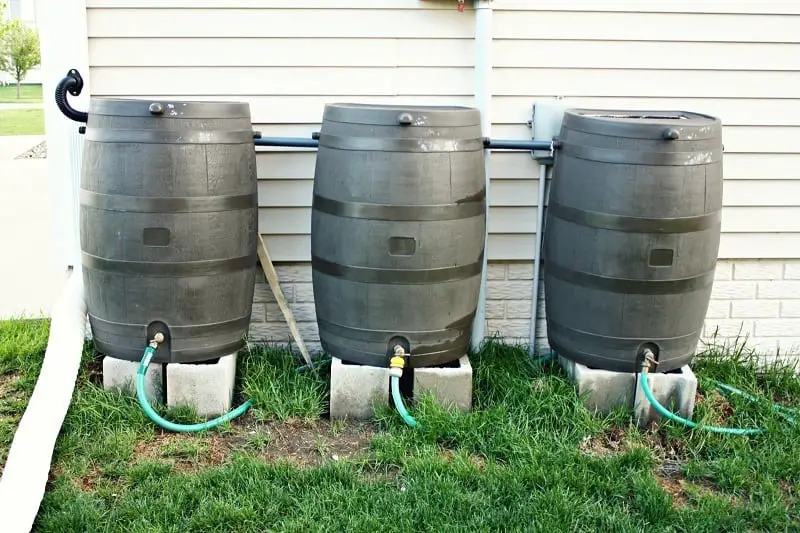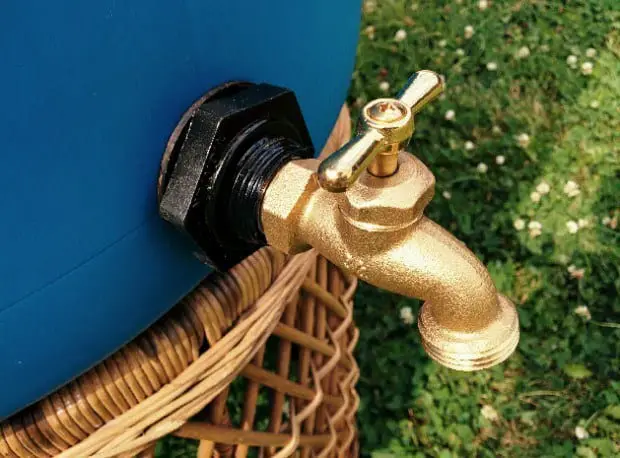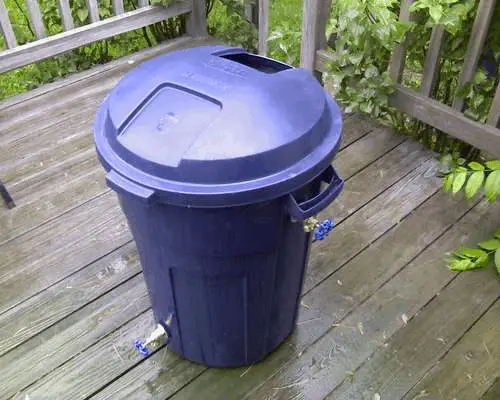How to Set Up A Rain Barrel on Your Property and Use It to Water Your Garden
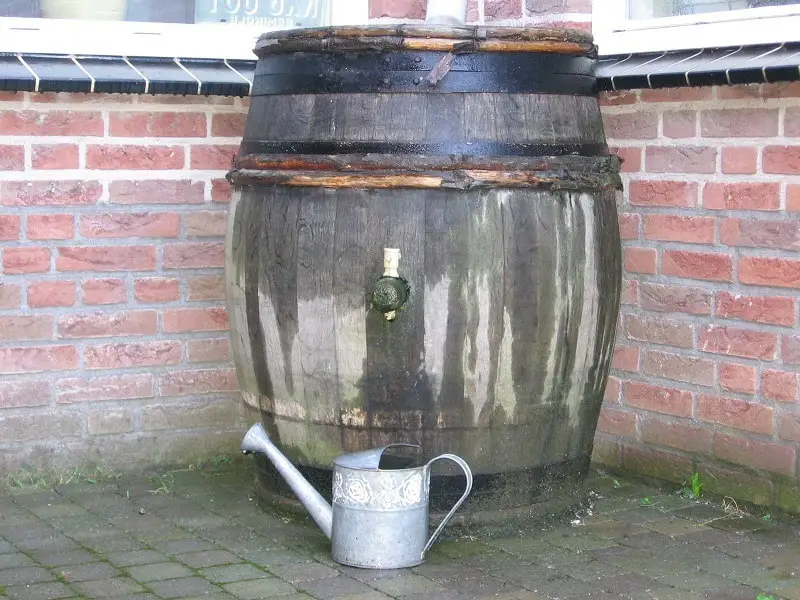
Quick Navigation
For decades homes around the country often had rain barrels to help collect rainwater for use both personal use and for watering their gardens. You can spend as little as $20.00 on a plastic barrel and stick it under a convenient downspout or you can invest hundreds of dollars on a sophisticated system of barrels, plumbing, pumps, valves, and more. Either way, the idea is to harvest all that “free” water coming down from the skies.
Before You Get Started

Before you invest too much time in learning about or installing a waster barrel system on your property, there is one very important step you need to take. This to check with your local and state laws regarding whether you are allowed to install water barrels on your property or not.
In recent years, more states have begun to ban their use. Their reasons for doing this is that the rainwater is needed to refill rapidly dwindling aquifers deep in the earth.
The laws are often confusing and require explanation, if you find your state on this list, your best bet is to go your local county permit office or county clerk to have them explain them to you in plain English.
How Much Water Are We Talking About
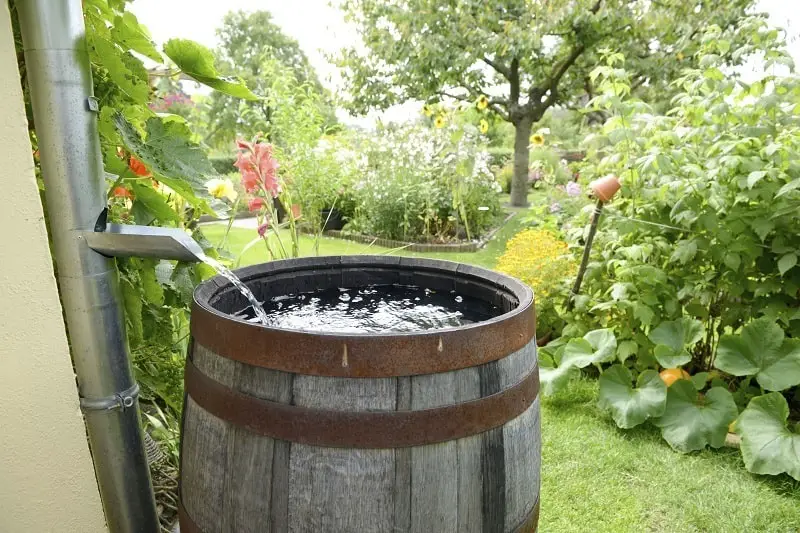
Can you collect enough water to make installing one or more rain barrels on your property? Well to help you get a picture of how much you can expect, let's take a quick look at the numbers.
If your roof measures 1,000 square feet, one inch of rainfall can yield up to 600 gallons of rainwater. So, if you have 10 inches of rain over the course of spring, your roof could easily supply you with up to 6,000 gallons of free fresh water.
You can use this online Rainfall Harvest Calculator to help give you a better idea of how much water your roof is capable of supplying you. Keep in mind you can use both slopes or more to collect water by placing a rain barrel on each downspout.
Why Install Rain Barrels
If you have a garden, you probably already know how much your annual water bill has gone up trying to keep your plants alive. Depending on where you live, no one could blame for thinking that having a garden isn't saving you any money at all due to the high cost of water. But, the simple fact is watering your garden from the city water supply can add hundreds of dollars to your water/sewer bill since you get charged by the gallon for both.
But, when you collect every drop of rainwater you can coming off your roof, not only is that water “free” but at the same time, you won't be paying anything extra on your sewage bill. If this isn't good enough, think of the high levels of chlorine and fluorine in your city water and then decide if this is the best water for your garden.
Bear in mind that the water coming off your roof is not necessarily clean as anything flushed off the roof such as gravel, dirt, bird poop, leaves etc. can and will end up in your water barrels. Unless, that is, you decide to go all out and filter the water before it goes into the barrels. Even at this the water is not potable and should not be used for drinking water.
Choosing a Water Barrel

There are several things you need to keep in mind as you start looking for the right water barrels. While most of us use a simple 55-gallon plastic barrel in any one of many styles, shapes, and colors. But, there are many others like those in this picture that bear no resemblance whatsoever to the traditional water barrel and can blend in perfectly.
To determine the right size and type of rain barrel, you need to decide how much water you would like the system to capture along with how you want the completed system to look.
Consider what you are going to use the water for, watering your garden, watering your lawn, washing your car, each of these takes large amounts of water, be sure your final system has a large enough capacity to meet your needs.
One good way to determine how muchyour waterr barrel system needs to collect in order to support your needs, is to look at last year's water bills. You should be able to see when the increase happened and how much extra water you used during the spring and summer months. Plan your water storage accordingly.
Water Storage
Then the next thing on your list is to decide if you are going to simply use the water caught in the barrels or if you are going to add some form of either above or below ground storage tank system. Here again, you need to decide how much water you need to store and how much money you want to store.
You can of course string several barrels together, creating hundreds of gallons of storage capacity. This type of system is relatively easy and cheap to put together, but as you can see it is a bit of an eyesore so make sure you buy much prettier barrels or storage systems for this type of setup.
Underground Storage Tanks
In countries like Australia many homes in the Outback use large underground rain water storage tanks to collect the vital water that keeps them alive during the dry season. You can do the same thing by having an underground tank buried in your yard and having the downspouts plumbed directly to the tank.
An underground tank can add hundreds, if not thousands of gallons in out of sight water storage to your home.
Building and Setting Up a Rain Barrel to Water Your Garden
The simple reality is that your rainwater collection system can be as simple as the one above or as complicated as you want to make it.
Keep in mind that the more complicated you make your collection system, the more maintenance it can take and the more problems you are likely to have.
Keep in mind the old acronym K.I.S.S – Keep It Simple Stupid. No offense meant, but often the simplest system is the best.
Gather Your Supplies
- 1 Large Water Barrel
- 1 Roll Teflon® Tape or Liquid Sealant
- 1 Spigot
- 2 Metal Washers
- 2 Rubber Washers
- 1 Drill
- 1 Drill bit
Prep the Barrel
Start at the bottom and work your way up
The first step is to drill a hole near the bottom of the barrel on the side. The hole needs to be the right size for the spigot or pipe you plan to install to just fit. If you make it too big, you may end up with a steady slow drip.
Take your time and do this right the first time. The reason for coming up a couple of inches is to keep the spigot above the level of any debris that falls to the bottom.
Top O' the Barrel Next

Next up, you need to cut a hole in the top of the barrel for the downspout to go into. You can put it in the middle like this image or all the way to one side, depending on how you plan to run the downspout into it.
Since the plastic is relatively thick, you should use a jig saw to cut the hole.
Installing the Spigot
Take the spigot, slide a large metal washer on first and then a rubber one and apply liquid Teflon®. Insert the spigot through the hole you drilled in the side. Add another bead of liquid Teflon®.
Finally, install the rubber washer then the metal one and finally the nut if you can find one to fit it or you can use a hose clamp pushed up tight against the washers.
Once the sealant dries, your assembly will not leak. Tip, drill the hole just a little too small so that you have to screw the spigot into the barrel, this will help hold it in place and seal better.
Setting Them Up
Now that your rainwater barrel is ready to go, the only thing left is to decide which downspout you are going to install it under and put it in place.
If you need more water pressure, you simply build a small platform using cinder blocks and 2 x 6 boards. In this picture the builder has connected three barrels together for more storage.
Pipe Diameter vs Water Pressure
For those who are not in the know, when you plumb your rain barrels in, you have a choice. You can opt for more water volume flowing through your pipes or opt for more pressure.
A larger diameter pipe will give you more water by volume which is great for doing things like filling pools. But if you want enough pressure to run a sprinkler you need to use a smaller pipe that while it may not deliver quite as much water by volume, but will deliver it under significantly more pressure, allowing the sprinkler to do a better job.
What Can You Use for a Rain Barrel?
To be honest you can use just about anything from a brand new large trash container to readily available fresh water barrels available from your local discount hardware superstores.
The most important things to look for are capacity, overall strength, suitability for the location, and finally aesthetics and cost. The simple fact is, that as long as the container suits your needs, you are on your way to captures all that water coming off your roof and storing it away for future use.
Down to the Final Drip

Putting together your own rain barrel water collection system can be as hard or as easy as you want it to be. From a single barrel to a complex system complete with multiple barrels, underground storage tanks, and pumps, the end result is the fun of building a system that can supply you and your garden with “free” water.
I hope the information above helps you put together your own rain barrel system. If it does, please let me know and send pictures (I love seeing how things turn out). If there is anything else you would like to see here, contact me here.
Related Articles:

